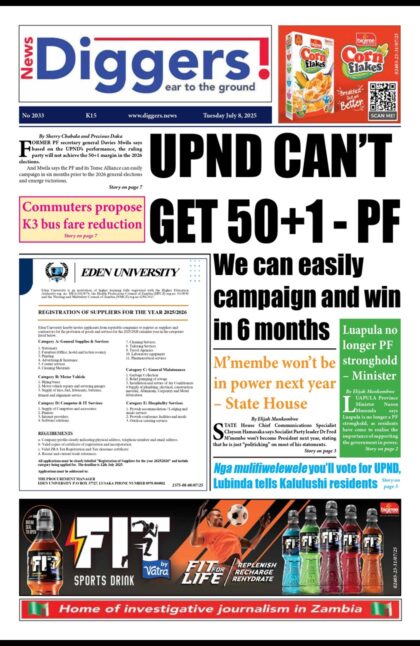Economist Chibamba Kanyama says an increase in fuel prices is imminent due to the continued the kwacha’s rapid depreciation against foreign currency convertibles.
And Kanyama has warned that Zambia’s annual rate of inflation is expected to continue escalating going into the New Year.
The kwacha depreciated to hit the K14.00 per dollar psychological barrier in mid-November for the first time in six months, owing to a resumption in high demand for the greenback on the local market.
Since then, the local unit rapidly lost value to close November at around K14.61 and K14.66 per dollar for bid and offer, respectively, according to the Bank of Zambia (BoZ).
In an interview, Kanyama observed that a fuel price increment was imminent.
He, however, added that it would be more profitable for government to subsidize fuel prices arising from the volatility in the exchange rate rather than increasing prices of the commodity.
The last fuel price increment the Energy Regulation Board (ERB) effected was on September 24 where the regulator hiked prices by five per cent, with a litre of petrol now selling at K15.98 from K15.20, mainly triggered by the depreciating kwacha and high oil prices on the international market.
“On the depreciation of the kwacha, it is surely a matter of time before the Energy Regulation Board (ERB) adjusts pump prices. We all know government is currently not in a position to absorb any market shocks arising from kwacha devaluation for lack of funds. However, given our projection of slow economic growth, the lowest in 11 years, it would be much more profitable for government to subsidize fuel prices arising from the high exchange rate than increasing prices,” Kanyama said.
“Zambian industry is currently stressed owing to load shedding, many of them keeping in business through diesel-powered generators. This is very expensive and it’s affecting output. We are anticipating a more than 50 per cent drop in productivity and output during the period of load shedding. Adjusting prices would just be suicidal because of the impact in value chains.”
He said the kwacha’s continued fall would negatively impact on government’s operations both in terms of next year’s budget and the Sinking Fund, which was operationalized to save and build resources to liquidate the country’s three eurobonds.
“The devaluation of the kwacha also implies government will now have to look for additional kwacha cover to purchase dollars for external debt repayments. Unfortunately, revenues through taxation are cast in stone; the only feasible cover for any losses in revenues are adjustments in non-tax revenues. Should the exchange rate sit at over K14 (per dollar), I see government failing to commit to the Sinking Fund; moreover, the 2020 budget was already pushed off balance the very week it was announced because of inflation. Now, add to that the high exchange rate, it will surely be a challenge, even for the budgeted imports that support government operations, such as medicines,” he said.
“The pressure on the kwacha is a cocktail of factors; a drop in copper revenues ignited by lower production and lower than expected prices of copper, importation of energy (electricity) and fertilizers, debt servicing, seasonal imports by industry and speculative behaviour. We should begin to witness stability by beginning of 2020 as we expect the Monetary Policy Rate increase to take effect. Should that fail, than we will know we have deeper (structural) economic problems to contend with.”
And Kanyama predicted a marginal increase in the country’s annual rate of inflation going into the New Year.
“Inflation will continue to marginally increase until about January/February, but should start to significantly slow down at the end of the first quarter (of 2020). I am expecting inflation to be between 8 and 9 per cent mid-2020 when food crop for the current agricultural season begins to hit the market. I should, however, state that inflation is dependent on weather and the distribution of farming inputs to farmers. The Zambia Met (Meteorological Department) has indicated we may have poor rains in February and this has implications already on output given that farmers have not yet planted because of the erratic distribution of inputs through the Farmer Input Support Programme,” said Kanyama.
“Key factor likely to drive inflation down is the Monetary Policy Rate (MPR) currently standing at 11.50 per cent. This has reflective impact on commercial bank lending rates to the private sector. We are expecting interest rates to move from the average 26.3 per cent to between 31 and 35 per cent in the coming few months. The cost of money implies a significant drop in private sector borrowings as well as salary-backed loans by retail consumers. The eventual impact is lower aggregate demand for goods and services and hence the expected stalling in upward inflation movements. The other likely impact will be on the demand for hard currency, which is likely to drop and hence a slight stability in the exchange rate.”



















